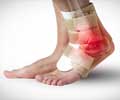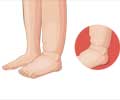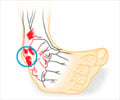A foot and ankle specialist at Hospital for Special Surgery in New York has revealed that the highest numbers of serious toe injuries are usually reported by athletes who compete in sports like football and soccer, which require them to make continuous cutting, loading and extending movements.
Dr. David S. Levine was referring to such toe injuries as might ultimately manifest into hallux rigidus, which develops over time at the joint by the base of the big toe.According to the American Academy of Orthopaedic Surgeons (AAOS), hallux rigidus usually develops in adults between the ages of 30 and 60 years from injuries sustained as early as high school sports.
However, researchers have yet to discover why some people develop hallux rigidus, while others do not.
Dr. Levine says that foot injuries sustained by sportsmen are sometimes known as ‘turf toe’, and lead to the development of bone spurs.
He says that all this can lead to hallux rigidus if not properly treated.
He also says that hallux rigidus injuries are not injuries where an athlete can simply tape up and play through it. According to him, not properly treating big toe injuries may lead to serious consequences.
Advertisement
The athletes then begin low-impact exercises like walking, stationary bicycle, and elliptical trainers to circulate blood flow.
Advertisement
Dr. Levine says that doctors have also started to treat toe injuries by inserting carbon fibres into athletes’ shoes. He says that doctors typically place padding that is designed to stop movement under the joint of the big toe, known as a Morton’s Extension.
Anti-inflammatory and corticosteroid injections are also options to treat pain from toe injuries nonsurgically, he adds.
Dr. Lavine insists that surgical treatment is reserved for patients who do not respond to medication and orthotics. He classifies the surgeries in two categories—for those whose joints are still salvageable, and for those who need to remove the joint.
He revealed that one of the surgical options is joint fusion, also known as arthrodesis. In this procedure, he says, surgeons fuse the two adjacent bones together and make them grow as one.
The surgery provides patients with lasting pain relief by eliminating arthritic joints, and improves their mobility considerably.
Source-ANI
LIN/M











